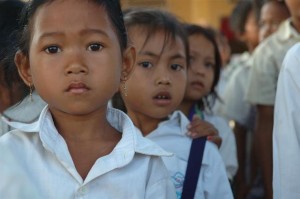UNICEF’s latest data reveal disparities, show need to innovate to advance children’s rights
2014-01-30
As 25th anniversary of children’s rights convention approaches, vast progress made but reaching unreached children will require sharper focus on disparities, new report says
NEW YORK/ HONG KONG, 30 January 2014 – Declaring that 'every child counts', UNICEF today urged greater effort and innovation to identify and address the gaps that prevent the most disadvantaged of the world's 2.2 billion children from enjoying their rights.

|
The children's agency, in a report released today, highlights the importance of data in making progress for children and exposing the unequal access to services and protections that mars the lives of so many.
“Data have made it possible to save and improve the lives of millions of children, especially the most deprived,” said Tessa Wardlaw, Chief of UNICEF’s Data and Analytics Section. “Further progress can only be made if we know which children are the most neglected, where girls and boys are out of school, where disease is rampant or where basic sanitation is lacking.”
Tremendous progress has been made since the Convention on the Rights of the Child (CRC) was signed in 1989 and in the run up to the culmination of the Millennium Development Goals in 2015. UNICEF's flagship report, The State of the World's Children 2014 in Numbers shows that: |


|
- Some 90 million children who would have died before reaching the age of 5 if child mortality rates had stuck at their 1990 level have, instead, lived. In large measure, this is because of progress in delivering immunizations, health, and water and sanitation services.
- Improvements in nutrition have led to a 37 per cent drop in stunting since 1990.
- Primary school enrolment has increased, even in the least developed countries: Whereas in 1990 only 53 in 100 children in those countries gained school admission, by 2011 the number had improved to 81 in 100.
Even so, the statistics in the report, titled "Every Child Counts: Revealing disparities, advancing children's rights," also bear witness to ongoing violations of children's rights:
- Some 6.6 million children under 5 years of age died in 2012, mostly from preventable causes, in violation of their fundamental right to survive and develop.
- Fifteen per cent of the world’s children are put to work that compromises their right to protection from economic exploitation and infringes on their right to learn and play.
- Eleven per cent of girls are married before they turn 15, jeopardizing their rights to health, education and protection. |
Data also reveal gaps and inequities, showing the gains of development are unevenly distributed:
- The world’s poorest children are nearly three (2.7) times less likely than the richest ones to have a skilled attendant at their birth, leaving them and their mothers at increased risk of birth-related complications.
- In The Niger, all urban households but only 39 per cent of rural households have access to safe drinking water.
- In Chad, for every 100 boys who enter secondary school, only 44 girls do – leaving them without an education and without protections and services that schools can provide.

|

|
The report urges increased investment in innovations that right the wrong of exclusion.
"Overcoming exclusion begins with inclusive data. To improve the reach, availability and reliability of data on the deprivations with which children and their families contend, the tools of collection and analysis are constantly being modified – and new ones are being developed. This will require sustained investment and commitment," the report says.
Much of what is known about the situations of children comes from household surveys, and in particular the Multiple Indicator Cluster Surveys (MICS). Designed and supported by UNICEF, MICS are conducted by national statistical authorities and provide disaggregated data on a range of topics affecting children's survival, development, rights and experience of life. To date, MICS surveys have been conducted in more than 100 countries. In the last round of MICS, interviews were completed in more than 650,000 households in 50 countries.
Thirty years have passed since The State of the World’s Children began to publish tables of standardized global and national statistics aimed at providing a detailed picture of children’s circumstances. With the release of an edition of the report dedicated to data, UNICEF is inviting decision-makers and the general public to access and use its statistics - at www.data.unicef.org - to drive positive change for children.
"Data do not, of themselves, change the world. They make change possible – by identifying needs, supporting advocacy, and gauging progress. What matters most is that decision-makers use the data to make positive change, and that the data are available for children and communities to use in holding duty-bearers to account,” the report said.









